Orion, NASA’s Next Generation Manned Space Vehicle, Has Successful First Test Flight
A wholly successfully first test for NASA's next generation manned space vehicle.
After a launch that was scrubbed yesterday due to wind at the launch site and a sensor issue with one of the main fuel valves, NASA successfully launched the first test flight of Orion, the next generation of manned spacecraft, and saw it return to Earth exactly as planned after what is being described as an essentially flawless test flight:
NASA’s new Orion spacecraft passed its first flight test on Friday, marking the beginning of what the space agency hopes will be a new era of human exploration beyond Earth’s orbit.
Carrying only test equipment and some souvenirs, the 20,000-pound spacecraft splashed down in the Pacific Ocean 630 miles southwest of San Diego at 8:29 a.m. local time, about four and a half hours after it was launched into orbit from Florida. NASA said the spacecraft appeared to function well throughout the brief flight and that the capsule landed just a mile off target.
“There is your new spacecraft, America,” a NASA spokesman said as Orion gently descended, its three main orange-and-white parachutes framed against wispy clouds in an otherwise blue sky. Later, NASA described the flight as “picture perfect” and a “significant milestone.”
The capsule, which had slowed from a maximum speed of about 20,000 miles an hour to 20 just before it splashed into the water, will be reeled in by a navy ship and towed to San Diego. Engineers and technicians will spend weeks poring over Orion and analyzing reams of data collected by sensors during the flight to determine how well the spacecraft’s systems and parts, including the capsule’s heat shield, performed.
Sitting atop a Delta IV rocket, the Orion capsule lifted off from Cape Canaveral Air Force Station on Florida’s Atlantic coast at 7:05 a.m. The launch had been delayed for a day after winds and a problem with the rocket’s fuel system forced a cancellation on Thursday.
With two boosts from the rocket’s second-stage engine, Orion circled Earth for two orbits, the second one carrying it to an altitude of 3,600 miles so it could achieve a high re-entry speed, close to the speeds expected if it were to return from a flight beyond Earth orbit.
The $375-million flight marks the beginning of in-space testing for the capsule. The next test flight is not expected until 2018 because of limited NASA budgets, and Orion will not carry astronauts until 2021 at the earliest. But NASA hopes that someday it will take people back to the moon or to Mars.
Following the delays and postponement on Thursday, flight controllers had been concerned that the launching might be postponed again because of high winds at the launchpad. But the winds stayed below the limit of about 24 miles an hour, and the Delta IV rocket, with three large boosters fueled by liquid oxygen and liquid hydrogen, ignited right on time and accelerated to supersonic speeds within 85 seconds.
More details from Space.com:
Today’s flight, called Exploration Flight Test-1, marks the first time a spacecraft built for humans has traveled out of low-Earth orbit since Apollo 17 launched to the moon in 1972.
Orion seemed to function well during its first flight. NASA officials tested many of the major systems that could be needed for future crewed missions with the capsule. In total, 55 percent of the capsule’s technology needed for a manned flight was tested Friday.
“It’s tremendously exciting. It’s so nice to see this happen and to see everything go so well,” NASA astronaut Rex Walheim, who represented the astronaut corps during Orion’s development, told Space.com. “We’re going to learn so much from this flight … To see it [Orion] coming back in was just an absolute thrill.”
Orion’s giant heat shield, the largest of its kind ever made, needed to withstand temperatures of up to 4,000 degrees Fahrenheit (2,200 degrees Celsius) when the craft hit Earth’s atmosphere as the capsule was flying through space at about 20,000 mph (32,000 km/h). The spacecraft’s parachute system also deployed well, slowing the capsule before splashdown in the Pacific Ocean.
A NASA drone flying above the Pacific during splashdown captured some amazing views of the capsule’s red and white parachutes descending into the Ocean.
Just after launch, Orion successfully jettisoned its launch abort system — technology designed to propel the capsule and its future astronauts to a safe distance in case of A suca problem during launch.
At a little more than 3 hours after launch, the second stage of the Delta 4 Heavy rocket also propelled Orion to an altitude of slightly over 3,600 miles (5,793 kilometers), about 14 times farther than the orbit of the International Space Station.
NASA officials used the approximately 1,200 sensors aboard Orion to monitor the way the capsule’s computers and other technology behave in the harsh space environment. Orion flew through belts of radiation twice during the flight (once on the way out, and again on the way back to Earth), allowing scientists to see how the spacecraft’s computers behave in high-radiation.
And more from CBS News:
Making only its eighth flight, the Delta 4 “heavy,” the most powerful rocket in the current U.S. inventory, put on a thrilling sky show for thousands of space center workers, tourists and area residents as it arced away to the east over the Atlantic Ocean.
Four minutes after liftoff, two of the three common booster cores making up the Delta 4’s first stage shut down and fell away, followed a minute-and-a-half later by shutdown and separation of the remaining first-stage core booster at an altitude of about 90 miles.
The rocket’s hydrogen-fueled second-stage engine then took over, firing for another 11-and-a-half minutes to put Orion into an initial orbit with a high point around 550 miles and a low point of just 115 miles.
Along the way, three large support panels were jettisoned as planned from the Orion’s service module, followed a few moments later by jettison of a dummy launch abort tower and spacecraft fairing, exposing the capsule to the space environment.
A second 4:42-firing of the second stage RL10B-2 engine was planned at the end of the first orbit to raise the high point of the second orbit to 3,600 miles, higher than any spacecraft intended for piloted operations since the final Apollo moon mission.
Falling back to Earth, the Orion capsule was expected to slam into the atmosphere 75 miles above the Pacific Ocean southwest of San Diego at nearly 20,000 mph, subjecting its heat shield to peak temperatures of some 4,000 degrees Fahrenheit.
After slowing to a more sedate 300 mph, the spacecraft’s flight computer was programmed to jettison a protective cover over the top of the capsule, followed by two stabilizing drogue parachutes. If all goes well, three huge main parachutes will unfurl at an altitude of about 1.2 miles to slow the spacecraft to less than 20 mph before splashdown west of Baja California.
Navy recovery forces were stationed nearby to recover the capsule and its parachutes and to carry out an initial assessment of the vehicle’s condition. The spacecraft will be hauled back to San Diego and then trucked to the Kennedy Space Center for detailed analysis.
The primary goals of Exploration Flight Test 1 — EFT-1 — were to subject Orion’s 16.5-foot-wide heat shield to the rigors of re-entry and to make sure its computer hardware, software and navigation systems could endure the higher radiation levels found outside the protection of the Van Allen belts that shield space station astronauts.
Equally important, engineers wanted to verify the performance of the giant braking parachutes and the pyrotechnic systems needed to jettison the service module structural panels, the capsule’s launch fairing and dummy abort motor and the protective parachute cover.
“This test flight is a big, big deal, because it’s going to give us an opportunity to demonstrate three big things about the vehicle,” NASA Administrator Charles Bolden told CBS News earlier in the week. “One, that it is capable of withstanding the temperatures and pressures of re-entry, so we’re looking at the heat shield and the structure itself.
“We’re looking for how (the spacecraft) performs on orbit, both (under) commands from the ground and autonomously while it’s doing things it’s programmed to do with its guidance and navigation system. And finally, once it makes its de-orbit and gets through the atmosphere and it’s time to decelerate, are the parachutes going to work? … The proof is in the pudding.”
The results of EFT-1 will be fed into the next Orion capsule, already under construction, that will fly in 2018 aboard the maiden flight of NASA’s new Space Launch System mega-booster designed to propel astronauts on deep space missions.
If all goes well, astronauts will strap in for Orion’s first piloted test flight aboard an SLS rocket in 2021.
NASA’s long-range plan is to use the new rocket and capsule to collect samples from a captured asteroid in the mid-2020s before an eventual flight to orbit and land on Mars in the 2030s.
But that will depend on NASA’s budget and the continued support of multiple administrations and Congress.
“The American public and their representatives in Congress and the president don’t seem to be willing to pay the money to do it any faster,” Logsdon said. “NASA’s doing the best it can on something like a starvation budget. Every external review that’s looked at the program for the past 25 years has said NASA needs more money; you’re trying to do a 20-pound program in a 10-pound bag
The Orion program is separate from another program being developed jointly by SpaceX and Boeing to develop what would essentially operate as a “taxi” for American astronauts to and from the International Space Station as a replacement for the Space Shuttle and, quite obviously, to reduce American dependence on Russian Soyuz craft to get astronauts on and off the space station. As with the unmanned vehicles that SpaceX has already sent to ISS successfully, with the next such mission scheduled to make deliveries later this month. A competing private launch system called Antares and developed by Orbital Sciences suffered a serious setback in October when the first flight of the system exploded shortly after liftoff from a NASA launch facility in Virginia. The SpaceX/Boeing project is based on SpaceX’s designs but would be used to send human beings to the station as well as cargo to the station. For anything more ambitious, including sending human beings back to the Moon, to near-Earth asteroids, or to Mars, though, NASA is going to need something far more powerful and sophisticated than the Boeing/SpaceX system. This is where Orion, and eventually the Space Launch System (SLS) rocket comes into play.
The SLS, which is described in greater detail in many articles on its NASA information page, is eventually intended to become the primary heavy lift rocket for NASA use, able to carry both crew and cargo into higher Earth orbit than the ISS and onto journeys beyond Earth orbit. In many respects, it would be the most powerful rocket that NASA has made use of since the legendary Saturn V that carried men to the Moon from Apollo 8 in 1968 through Apollo 17 in 1972. In its most powerful configuration, of course, the SLS would need to provide sufficient lift and escape velocity to propel a manned crew and everything that would be needed to support it to the surface of Mars, but that’s something that wouldn’t occur until the 2030s at the earliest and would require the resolution of a number of logistical issues ranging from the impact of long-term space travel on humans to issues involving exposure to the radiation of space once the crew has left the protection of the Van Allen Radiation Belt. Before we get there, though, SLS would likely be the means for Americans to return to the Moon for the first time since the early 1970s and, perhaps, the utilization of that more familiar and closer environment to experiment with the means by which humans could survive for long periods on the surface of Mars in a future mission. All of that is far off, of course, and we aren’t even likely to see the next test mission for Orion for another four years, but today’s developments were a significant first step toward reestablishing a manned space exploration program that, quite honestly, has been moribund since Gene Cernan and Harrison Schmitt left the surface of the Moon on December 14, 1972.
Here’s video of the launch as covered by NASA television, including post-launch video of Orion as it began to enter orbit (close up launch video here):
And here’s the splashdown:
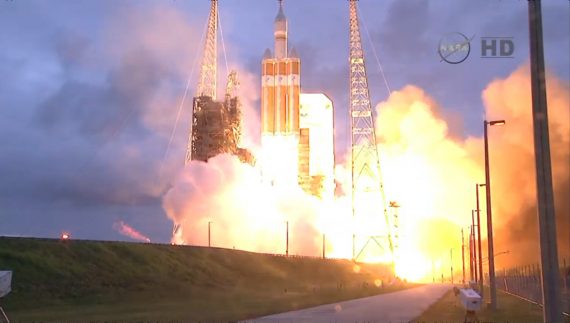

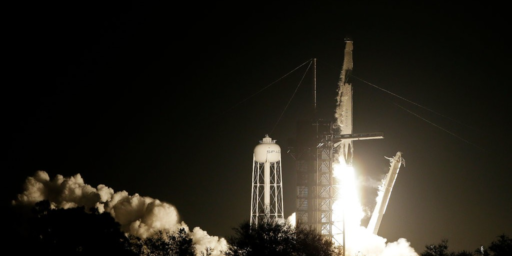
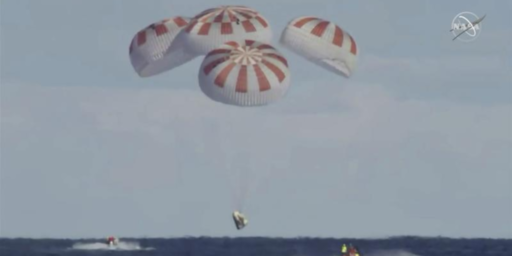
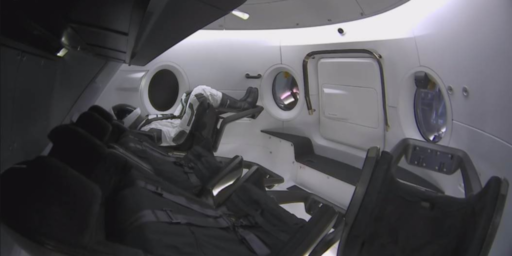
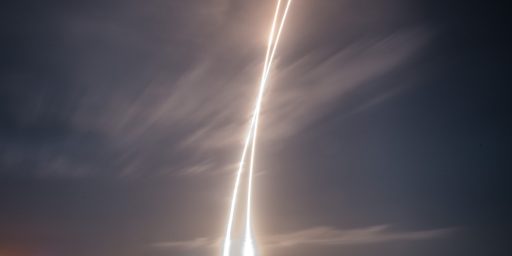
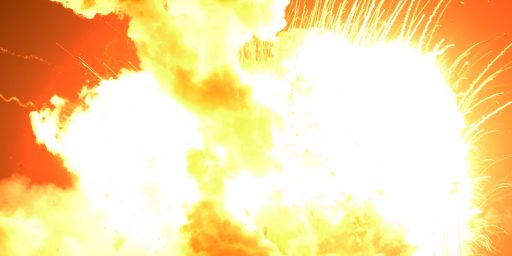
Way cool.
“SLS would likely be the means for Americans to return to the Moon for the first time since the early 1970s “
Well, no. Mr. Obama has pretty bluntly denied that returning to the Moon is not a goal. “Been there, done that.” Nor has Congress really disagreed with him. You’ll note that NASA is not designing a Moon lander to fly with Orion, and there are no plans for lunar bases or even Apollo-style excursions for any time in the future. One flight to a miniature asteroid in the 2020’s and that’s it for human flight out of earth orbit until maybe the mid-2030’s.
That’s your manned space program. If Congress and the public are willing to pay for it — which strikes most people as unlikely.
On the other hand, July 20, 2019 will be upon us in a few years. I’m sure the President and every member of Congress will make excellent speeches about American courage and determination and Our Leadership in Space. Maybe we’ll get a few television or Netflix specials and half a dozen YouTube videos commemorating the Apollo program. That’s all any of us really wants, isn’t it?
$375 million to test a capsule? You can’t really believe that, can you? All that lift energy just to test an empty can? Inconceivable!
I’m quite certain the NSA/CIA/Military used the opportunity to slip a black project aboard which is now happily circling the globe. I’d be disappointed in them if they didn’t.
On the other hand I’m glad the can passed the test.